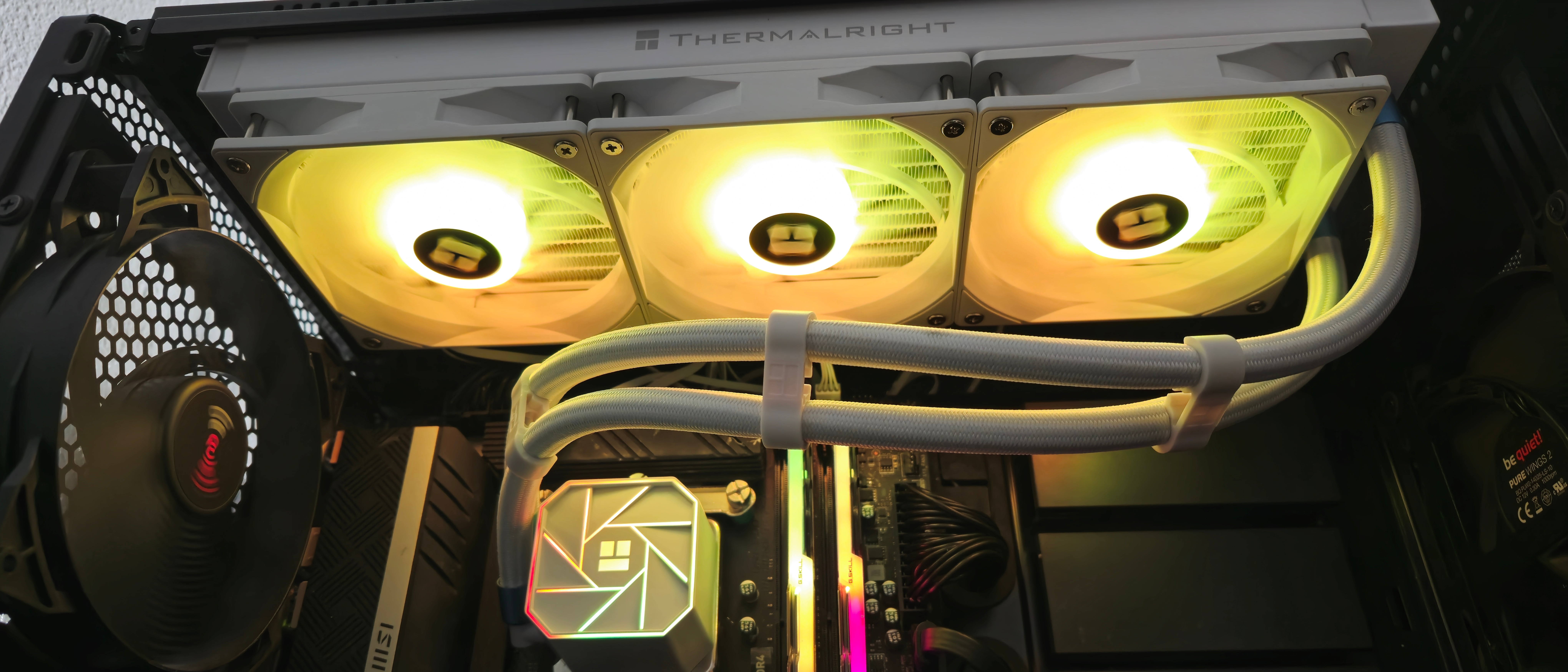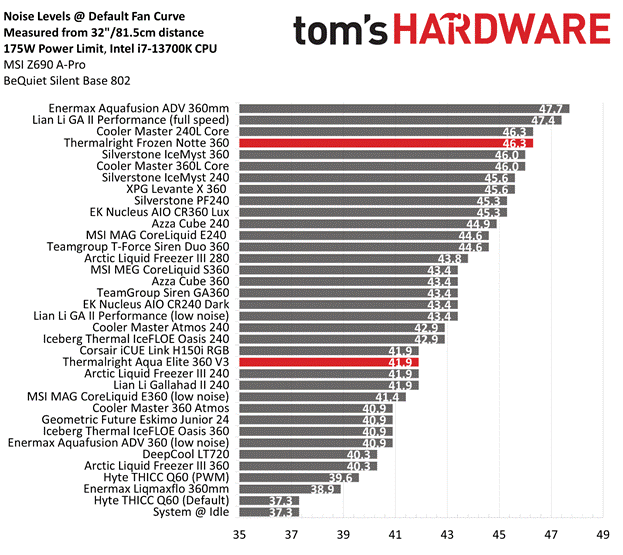Why you can trust Tom's Hardware
Thermal results without power limits
Without power limits enforced on Intel’s i7-13700K, the CPU will hit its peak temperature (TJMax) and thermally throttle with even the strongest of air coolers. When the CPU reaches its peak temperature, I’ve measured the CPU package power to determine the maximum wattage cooled to best compare their performance.
The general exception to this comes with the strongest AIOs on the market, which can keep Intel’s i7-13700K under TJMax. This is no small task, as most 360mm AIOs still fail this test.
The Frozen Notte 360 does very well here, matching the performance of the 360mm AIOs which are tied for my 2nd best thermal results – but it runs rather loudly to do so, reaching up to 52.5 dBA. The Aqua Elite 360 V3 doesn’t do as well thermally, but it runs much quieter with a maximum noise level of 46 dBA.
Thermal results with noise normalized to 38.2 dBA
Finding the right balance between fan noise levels and cooling performance is important. While running fans at full speed can improve cooling capacity to some extent, the benefits are limited and many users prefer a quieter system. With this noise-normalized test, I’ve set noise levels to 38.2 dba. This level of noise is a low volume level, but slightly audible to most people.
Both of Thermalright’s AIOs perform well when noise normalized to a low 38.2 dBA. Thermalright’s Aqua Elite 360 cooled 232W in this test, the Frozen Notte performed slightly better cooling 235W.
175W Cinebench results
Most coolers on the market can keep Intel’s i7-13700K under its peak temperature if the power consumption is limited, so for this test, we’ll be looking at the CPU’s actual temperature.
In a more moderate 175W thermal load, both of Thermalright’s offerings had middle of the road results for an AIO. The Frozen Notte’s noise levels were on the higher end compared to other AIOs, reaching 46.3 dBA. Users wanting a quieter experience should look to the Aqua Elite 360 V3 instead, which only reached 41.9 dBA – one of the quieter results in this scenario.
Get Tom's Hardware's best news and in-depth reviews, straight to your inbox.
125W Cinebench results
The lowest power limit I test with Raptor Lake CPUs is 125W. This is a high enough limit to allow the CPU to maintain its base clock speeds even in the most intensive tests, and most coolers should be capable of keeping the CPU below TJmax (the max temperature before throttling) – even low-end coolers.
Really, thermals do not matter in this scenario. Even Intel’s stock cooler can handle a load like this with ease. Noise levels, rather than CPU temperature, are the most important factor here. The noise levels of both coolers were acceptable, with the noisier Frozen Notte 360 only reaching 38.9 dBA. The Aqua Elite 360 ran just a little quieter, reaching 38.2 dBA.
Conclusion
Just as with its air coolers like the Phantom Spirit 120 EVO, Thermalright’s liquid coolers provide a great value with low prices and strong thermal performance. The Frozen Notte 360 runs a bit louder than it needs to out of the box, so I’d advise manually tuning the fan curve if you’re considering that model. The Aqua Elite 360 V3 has much better overall noise levels, but it isn’t quite as strong.
MORE: How to Buy the Right CPU Cooler
MORE: How to Check CPU Temperature
MORE: All CPU Cooling Content

Albert Thomas is a contributor for Tom’s Hardware, primarily covering CPU cooling reviews.
-
JamesLahey Frozen Notte 360 user here:Reply
Glad to see this capable and very budget friendly aio get some airtime.
When I bought mine I couldn’t find any mainstream reviews, and I took a chance on it.
I was replacing a Noctua NH-D15, only because I wanted to vertical mount my gpu, for aesthetics.
Fan control software is a must if you want to really fine tune your sound profile, but I never had anything but great performance from the cooler.
I didn’t notice the inline pump when I purchased it, but other than wondering why it had a fan header attached to a weird plastic lump for a few minutes, it was never an issue with tube routing or noise.
These are exceptional coolers at a price that competes with budget air options. -
GravtheGeek At last we seeReply
a review for this line! With the 360 only $65 and the 240 only $50, it's amazing it's taken this long to see some reviews for it. Seems like the go to for cheap AIO cooling.Admin said:With performance this good, it’s hard to believe it’s available for less than $65 USD
Thermalright Frozen Notte and Aqua Elite 360 White V3 Review: Strong AIOs available for less than $65 : Read more -
thestryker Given how long Thermalright has been in business and they carry decent warranties it certainly seems to be as fantastic a deal as their air coolers. It looks like they use multiple ODMs for their pumps which may be part of the reason they're able to have such low prices.Reply
With new CPUs coming out this year it will be interesting to see if anything changes on the cooler front since Intel's cores should be offset similarly to AMD. -
parkerthon Just fyi, this is a vertical case and the block outlet tubes should be oriented facing up when you install it. Not sideways and definitely not down. Otherwise air bubbles can potentially get trapped in block and burn out the pump. Pretty much everyone, including Toms it would appear, doesn’t pay attention to this proper installation detail and instead focuses on the aesthetics of routing the tubes to the radiator. This is why some pumps die prematurely or whine out of the box. GamersNexus did a big thing on it, but it should be noted in the install instructions.Reply -
tlkraus1965 Reply
I'm not sure of the issue here. The radiator is at the top of the loop with the tubes facing down so the air should rest at the top of the radiator which is well above the pump. In the Gamer's Nexus video I watched, the tube orientation at the pump was not addressed, only that the pump is below the loop and try to avoid air at the connection barbs of the radiator.parkerthon said:Just fyi, this is a vertical case and the block outlet tubes should be oriented facing up when you install it. Not sideways and definitely not down. Otherwise air bubbles can potentially get trapped in block and burn out the pump. Pretty much everyone, including Toms it would appear, doesn’t pay attention to this proper installation detail and instead focuses on the aesthetics of routing the tubes to the radiator. This is why some pumps die prematurely or whine out of the box. GamersNexus did a big thing on it, but it should be noted in the install instructions.







